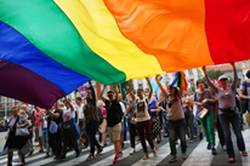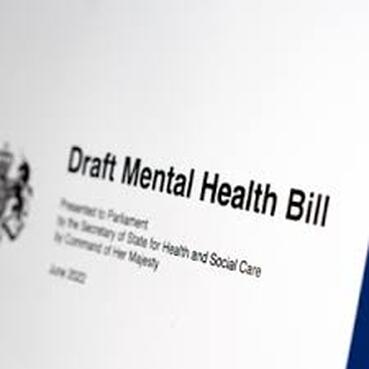|
This piece originally appeared in the DCC-i June 2022 Newsletter.  Pride in Social Work with Trans People? I recently came out as non-binary at work. I’d angsted at trans friends about the decision and tried to ignore the feeling of inauthenticity tickling at the back of my mind for longer than I’d like to admit. Then there was a Government leak stating that trans people would not be included in the ban on so called “conversion therapy”. I realised that the importance of visibility as a trans social worker within mental health services outweighed my discomfort at asking colleagues to change the language they used about me and to maybe consider the existence of gender outside of a binary. So what took me so long? The UK is an increasingly dangerous place to be trans. A 2020 Galop survey found that transphobic hate crime had doubled in the last three years, and that was only hate crime that was reported to police. The survey also found that only one in seven people felt able to report incidents of transphobia. In 2021 the Council of Europe Committee on Equality and Non-Discrimination published a report condemning “the extensive and often virulent attacks on the rights of LGBTI people for several years” in Hungary, Poland, the Russian Federation, Turkey and the United Kingdom (Ben Chikha, 2021:2). The report warned that the rights of trans and non-binary people are being rolled back in the UK leading to human rights issues, and that this is being propagated by politicians and others in positions of power. I’m in a position of privilege and relative power, but I can’t ignore this context. And unlike when being open about other aspects of my identity, I couldn’t be certain of support from my social work community. Are trans rights a social work concern? We are in the midst of a moral panic that seeks to position the rights of trans people, particularly trans women, in opposition to the rights of children and cis women (Pearce et. al, 2020). Transphobic articles published by major UK newspapers and broadcasters portray trans people as sexual predators and pathologise trans people as deluded or mentally ill. A dip into the toxic morass of “Gender Critical” Twitter or a certain online forum for mothers could give the superficial impression that trans rights are a safeguarding issue. Given the current climate of polarised views and misinformation, and that research has demonstrated that social workers do not feel prepared by their training to work with trans people (Stevens, 2022), perhaps the lack of engagement around trans rights from (cis) social workers is understandable. However, trans rights are very much a social work concern. Trans rights are human rights. Promoting human rights and social justice is core to social work. It’s woven throughout our codes of ethics and professional standards. BASW’s 2021 position statement on social work with trans people was a welcome interruption to the social work silence on trans issues. It highlights that opposing the oppression, stigma, discrimination and abuse that trans people face is in keeping with the BASW code of ethics and the social work purpose to uphold human rights (BASW, 2021). Trans people face barriers to all forms of healthcare, have higher levels of self-harm and suicide, are more likely to be unemployed or in low wage jobs and more likely to face homelessness than the general population (Pearce et. al 2020, Galop 2020, McNeil et. al 2012). The 2021 Council of Europe report states that transphobia in the UK breaches Article 14 rights. In 2020 Women and Equalities Minister Liz Truss spoke about reforms to the Gender Recognition Act 2004, mistakenly conflating the provisions of the Act with enabling access to “single sex spaces”, saying that “appropriate checks and measures” need to be in place regarding who accesses these spaces. This poses questions about self-determination and Article 8 rights. Trans rights are your rights. Attempts to challenge or remove rights from trans and non-binary people also impact the rights of cis women, children and other members of the LGBTQ+ community. The main proponents of the “Gender Critical Movement” are predominantly white, middle class, affluent people in positions of power with platforms in the press, universities and parliament. This movement does not represent the interests of working class, racialised and/or minoritised people. The Bell & Anor v. Tavistock & Portman NHS Foundation Trust case briefly (from initial judgement in 2020 until being overturned on appeal in 2021) set a judicial precedent that overrode Gillick Competence with potentially dire consequences for under 16s’ bodily autonomy. Let’s not forget that Gillick v West Norfolk and Wisbech Area Health Authority related to access to contraception. “Gender Critical” arguments against trans rights centre around biological essentialism, stating that women have “sex based rights” that must be protected (see Fair Play For Women, A Woman’s Place UK, etc., ad nauseam). Sex is presented as immutable. “Males” (incorrectly including trans women) are presented as stronger and biologically predisposed to sexual violence. “Females” are presented as fragile, vulnerable and in need of protection, reminiscent of outdated, misogynist notions of the ‘the weaker sex’ (Pearce et. al, 2020). Some “Gender Critical Feminists” go further to define womanhood by the ability to reproduce (e.g. Suzanne Moore in the Guardian, 2019), previously the preserve of anti-choice, fundamentalist religious organisations. Other “Gender Critical” groups state that exposing school children to information about gender and sexual identities (e.g. through the Stonewall School Champions programme) is a safeguarding concern, at times equated to grooming. As someone who attended school under section 28, this is uncomfortably familiar. What can social workers do?
Useful Web Links / Resources
Lizzie Furber (they/them) DCC-i Associate & mental health social worker June 2022  This piece was originally published in the DCC-i June 2022 Newsletter. So, the government will over the next year or so, draft legislation to reform the Mental Health Act (MHA). What is not to like? They intend to modernise the MHA & promise to make what is basically 1950’s legislation, fit for the 21st century. The plan is to give patients suffering from mental health conditions greater control over their treatment & to ensure that they receive the dignity & respect that they deserve. This new legislation is going to address the existing disparities in the use of the MHA for people from ethnic minorities. But it is going to keep CTOs #JustSayingLike. “In 2020-21, black people were four times more likely than white people to be detained under the Act, and over ten times more likely to be placed on a Community Treatment Order.” What is that all about then? What about us #AMHPs? Are we part of the problem or part of the solution? Can I suggest you read this summary by Mithran Samuel over at Community Care & the responses & make of it what you will. I am also not seeing any plan to do anything about poverty, inequality & substandard housing etc. You know the import stuff & Social Determinants of health & the cost-of-living crisis. They want to make it easier for people with learning disabilities & autism to be discharged from hospital. They are also amending the definition of mental disorder and the hope is, that adults and children with learning disabilities & autism, will not be detained in the first place. I applaud the intended consequences, but I do wonder about the investment in community provision & alternatives to hospitals & about the unintended consequences & about things like S.117. Be careful what you wish for, and it’s not just me, smarter people than me are wondering about this stuff also, see what the ever-learned and plain speaking Lucy Series has to say about it here. They are proposing to change the criteria needed to detain people so that the MHA is only used when it is strictly necessary. When the person is thought to be a genuine risk to their own safety or that of others & they are introducing the notion of therapeutic benefit. So, adults and children will in theory, only be detained when it is thought to be of therapeutic benefit to them. A certain contested diagnosis springs to mind & something about having capacity & about taking responsibility. Just think about that for a minute, about what that means in practice. I don’t think sending people/children 100’s of miles away to out of area beds is a therapeutic thing. Plus who gets to decide/assess what genuine or substantial risk is? I suspect that is you & me #AMHPlife & a doctor or two. If you can find a S.12 medic in the dark of the night. I don’t ever speak to any #AMHPs, or indeed doctors, who currently think that they are detaining people/children when it is not strictly necessary. I do speak to #AMHPs & Drs & families who acknowledge that they are detaining people/children because there is no other option or alternative available to safely manage/contain risk. Imagine you or I don’t detain someone, because we don’t think there is avtherapeutic benefit & it all goes wrong. I am not sure that I am looking forward to explaining that particular decision (made without the benefit of hindsight & with limited information & under pressure) in the criminal or coroner’s court. There will be more advocacy for people & the Nearest Relative will become a Nominated Person & they will have greater powers to say no & to be consulted about things like CTOs. Who is funding & providing that advocacy? What does it look like in the real world? What if the person doesn’t nominate a person? What if the Nominated Person just says no & no & thrice no & they are not helpful & you think they are unreasonable or unsuitable? Those really ill people in HMPs will be transferred to hospitals within 28 days. *If there is a bed. There will be a new form of supervised community discharge, that will allow us to deprive people of their liberty. But only the really risky ones. Remember the MM & PJ cases tell us, that we cannot use the provisions of the MHA (S.7, S.17A or S.41) to deprive capacious community patients of their liberty, even if they are assessed & thought to be really v risky to self or others. What is that going to look & feel like in the real world? People subject to the provisions of the MHA, will be able to appeal to Tribunals more often & they will be given a statutory care & treatment plan. This plan will be written with them & will set out a clear pathway to their discharge. Some plan that, & of course it will do away with S.117 disputes & funding panels & CHC & CCG squabbles over £s & provide housing with the appropriate level of support & sort benefits & deal with the DWP. It seems that the proposed & much discussed extension of Section 5 holding powers to the Emergency Department (ED), is not going to be a thing. The solution to the problem of adults/children being assessed as requiring admission, but there being no bed/hospital willing to accept the #AMHP application, is I was told, going a be none legislative one. I didn’t quite figure out what that answer meant or might look like in a police custody block, when the PACE clock has ticked & tocked. Other than an ever-increasing number of S.136s & other improvised solutions to system dysfunction. It is at this point that I usually mention S.140 anyone? Did I mention that me & Steve Baker our #CrewCop do joint training for #AMHPs & the girls & boys in blue & the odd Bed Manager? Last year (1920/21) in England there were 53,239 civil detentions under the MHA & something like 1,520 new restricted patients admitted to hospital for treatment. It is not 53,239 people by the way. It probably equates to about c.35,000 people & it doesn’t include people detained on S.136. - complicated this isn’t it? While like many, I really do appreciate the work undertaken by Sir Simon Wessely & his team & the MHA really did need updating & I enjoyed v muchly the odd train trip (consultation event). I can’t help but think (unfortunately, I am old enough & was an ASW in 2007), that it is again a missed opportunity to bring about real change. That the problems are not really rooted in the legislation. That it really is about the other stuff - poverty, inequality & substandard housing. About the lack of investment in the community alternatives & early intervention. If we really want to reduce the numbers of adults and children being detained, then we need to stop calling #AMHPs & we need to stop relying on the MHA as the solution to the problem. We do need to think about risk & perception of risk in a different way & we need to support people & families much better. Otherwise, I fear, that me & others, will simply be writing things like substantial & genuine risk on pink forms & writing that it is of therapeutic benefit & that LD dudes & autistic people will attract another diagnosis. I hope that I am wrong. I fear that I might be right #AMHPlife. Tony Deane Principal Social Worker & #GrumpyAMHP @asifAMHP |
AuthorSNews, views and rambling rants from the DCC-i Crew... Archives
September 2022
Categories
All
|
|
DCC Interactive Ltd
Registered Office: 22 St John St, Newport Pagnell. MK16 8HJ Registered in England & Wales, Registration No: 13075266 Contact: [email protected] Registered with the Information Commissioners Officer, Registration No: ZA839281.
|
Our Accreditations: |


 RSS Feed
RSS Feed





